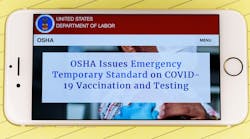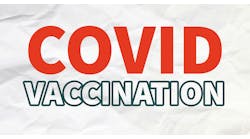President Biden’s workplace vaccination requirement for large employers may be blocked by a preliminary injunction issued by a federal appeals court, but that hasn’t stopped his administration from insisting that employers continue to follow the new rule.
Earlier this month, the Occupational Safety and Health Administration (OSHA) issued an emergency temporary standard (ETS) requiring that employers with 100 or more employees must have all of their workers vaccinated against COVID-19 no later than Jan. 4, 2022. The next day, the Fifth Circuit court of appeals issued a preliminary injunction blocking enforcement of the ETS while challenges to it are heard in the federal court system.
Immediately following issuance of the Fifth Circuit’s first stay, White House spokesperson Jen Psaki directed employers to continue working to advance the mandate. That caused a three-judge panel of the Fifth Circuit a few days later to issue a blistering attack on the ETS and reiterate their stay order.
Because so many lawsuits have been filed challenging the ETS throughout the country, a single federal appeals court—the Sixth—was selected randomly on Nov. 16 to hear all of them. That might not bode well for prospects of the standard’s survival because of the 27 judges currently serving on that court, 20 of them were appointed by Republican Presidents going back to Ronald Reagan, including six who were named by Donald Trump.
None of this daunted the Biden administration, which immediately declared that it would vigorously defend the ETS in court. After that, Psaki issued a second announcement from the White House telling employers they should continue operating on the assumption that the ETS will survive and also asserting that employers are still expected to adhere to the standard’s earliest requirements, which they are expected to fulfill no later than Dec. 5.
Assuming the ETS is upheld, after Jan. 4 employers could face significant consequences for not having met those requirements or being ready to force their employees to get vaccinated.
“Our message to businesses right now is to move forward with measures that will make their workplaces safer and protect their workforces from COVID-19,” Psaki said on Nov. 18. “That was our message after the first stay issued by the Fifth Circuit. That remains our message and nothing has changed. We are still heading towards the same timeline. The Department of Justice is vigorously defending the emergency temporary standard in court and we are confident in OSHA’s authority.”
Other private organizations that have embraced the OSHA ETS mandate also told employers they should continue to implement the mandate in spite of the court injunction, including the American Medical Association and U.S. Chamber of Commerce.
“Ultimately the courts are going to decide, but employers still need to take this as a live ETS until it is definitively shut down,” Marc Freedman, the chamber’s vice president of employment policy, said in a Nov. 15 CNBC television interview. “They should not bank on the preliminary actions of the Fifth Circuit.”
Opponents of the mandate include the National Retail Federation, American Trucking Associations and the National Federation of Independent Business, as well as the attorneys general of at least 26 states. Some labor unions wish to see the ETS expanded to include employers of 99 or fewer employees.
Also keep in mind that 21 states and Puerto Rico maintain their own state OSHA plans. Those states were given 30 days from the issuance of the ETS on Nov. 5 to adopt the federal standard or inform OSHA of their plans to enact some variant of the ETS, the Society of Human Resource Management reminds employers.
For those state-plan states that have passed laws or otherwise declared their opposition to the ETS and other vaccine mandates, OSHA is taking a hard line and threatening to pull their authorization for maintaining their own enforcement agencies. OSHA already has announced it is “reconsidering” its intention to revoke approval of state plans in Arizona, South Carolina and Utah.
In addition, the Biden administration’s other requirement that federal contractors and subcontractors ensure their employees are vaccinated separately faces legal challenges in different parts of the country, but those challenges have yet to result in an injunction and have not yet been gathered together in a single court.
How to Get Ready
Although the full implementation deadline is Jan. 4, under the ETS requirements employers also have certain obligations they need to fulfill no later than Dec. 6. Among these are:
• Start reporting work-related COVID-19 fatalities to OSHA within eight hours and work-related COVID-19 in-patient hospitalizations within 24 hours.
• Issue to employees (in languages they speak) the employer’s written policy on mandatory vaccines and/or testing in lieu of vaccination and other information about OSHA anti-discrimination and retaliation; prohibitions on providing false statement and documents; and the efficacy, safety and benefits of the COVID-19 vaccine.
• Require unvaccinated employees to wear a face covering or face mask in the workplace most of the time.
• Provide employees with up to four hours of paid time off to receive each dose of a COVID-19 vaccine.
• Provide employees with a reasonable amount of paid sick time to recover from any side effects from receiving each dose of a COVID-19 vaccine.
The most burdensome requirement of the ETS is the Dec. 6 deadline for employers to determine their employees’ vaccination status, collecting and retaining proof of it and creating a roster of employees’ vaccination status, according to attorneys for the law firm of Kilpatrick Townsend & Stockton. “Depending on the size of the workforce, gathering this information can take a significant amount of time,” the lawyers note.
Each employee must provide acceptable proof of vaccination status, as listed in the ETS. Employees who do not provide this proof are not fully vaccinated for ETS purposes. Importantly, if an employer already has collected and retained vaccination status information before the ETS becomes effective, the employer will be in compliance in regard to these employees (but only those employees), the lawyers explain.
The National Labor Relations Board (NLRB) also announced in a recent memo that unionized employers will continue to be obligated to negotiate with their unions regarding those issues where, under the OSHA standard, management continues to have discretion.
Although the board did not specify which components of the ETS it views as discretionary, they may include the decision of whether to establish, implement and enforce a policy that mandates vaccination or allows employees to choose whether to be fully vaccinated or provide proof of regular COVID-19 testing and wear a face covering, note James Holt and Brenda Rosales-Carrillo, attorneys with the Reed Smith law firm.
Other collective bargaining obligations also may occur because of costs arising from vaccinations and testing. Other bargaining topics could stem from how COVID-19 testing will be conducted, and how employees will be removed from the workplace for failing to submit a negative test as required under the ETS.
A duty to bargain over any ETS-related decisions may already be satisfied under existing labor agreements. “Employers should determine whether any existing collective bargaining agreements or other labor agreements include applicable provisions, such as those provisions addressing management rights and workplace health and safety,” Holt and Rosales-Carrillo say.
Employee vaccine records and rosters are confidential medical information, they stress. “Thus, employers should bear in mind that the information should be accessible only by those with a need to know, which means that only a limited number of employees will be able to assist with gathering and maintaining the requisite information.”
In addition, employers must be careful not to directly communicate an employee’s vaccination status to the worker’s supervisor or any other employees who are not responsible for maintaining the vaccination records.
However, as a practical matter, Holt and Rosales-Carrillo admit, because unvaccinated employees are required to wear a mask in the workplace, anyone responsible for enforcing the mask requirement will need to know which employees are required to wear masks and it is likely to be obvious to their co-workers. In spite of this, the attorneys warn that employers should be careful to communicate only that a particular employee is required to wear a face mask and refrain from indicating or confirming vaccination status.
As you can see, many of these obligations will require weeks to fulfill in most cases. Although OSHA is blocked from enforcing the ETS provisions until after the Sixth Circuit vacates its stay or ultimately decides in favor of the standard (or is not stayed while on appeal to the Supreme Court), employers will face an OSHA ready to launch enforcement efforts as soon as it can.




